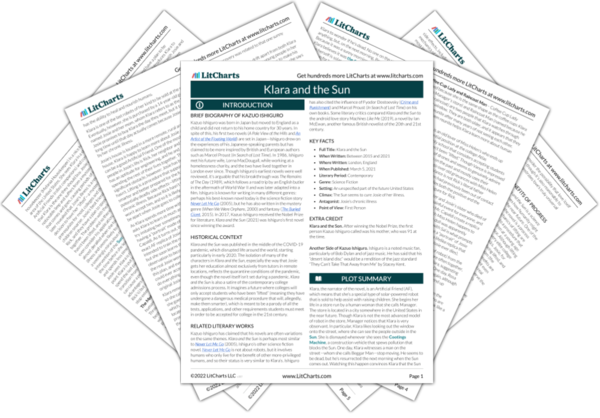The Meaning of Love
Kazuo Ishiguro’s Klara and the Sun is a story that looks at love from a variety of different perspectives. Perhaps the most difficult question about love that the novel poses is about whether or not love itself is a strictly human experience. The “portrait” of Josie that Mr. Capaldi makes particularly emphasizes this question. The “portrait” is actually a robotic replica of Josie, and the Mother’s plan if Josie dies is for Klara—a robot—to…
read analysis of The Meaning of LoveCosts and Benefits of Progress
Kazuo Ishiguro’s Klara and the Sun is a science fiction novel that imagines how humanity might progress (or regress) in the near future. One of the most important futuristic concepts in the novel is a process called “lifting.” Although the precise mechanics of lifting are intentionally left vague, it seems to refer to a procedure that parents choose to have done on their children at a young age for the purpose of increasing their intelligence…
read analysis of Costs and Benefits of ProgressFaith and Hope
One of the unusual aspects of Kazuo Ishiguro’s Klara and the Sun is that the most spiritual character is a robot. Although human characters occasionally say things like “Oh my God,” there’s nothing to suggest that any of them are particularly religious. By contrast, while Klara also has no traditional concepts of any god or religion, she treats the Sun as if it’s a personal god with the power to intervene in her life as…
read analysis of Faith and Hope
Environmentalism
One of the central paradoxes of Klara and the Sun is that, while Klara is a robot created by humans out of artificial materials, she gets nourishment from nature: in particular, the Sun. Even though Klara is a product of industrialized human society, then, she appreciates nature more than many of the humans around her. One of the recurring images in the book is the Cootings Machine (which seems to be some sort of…
read analysis of Environmentalism






